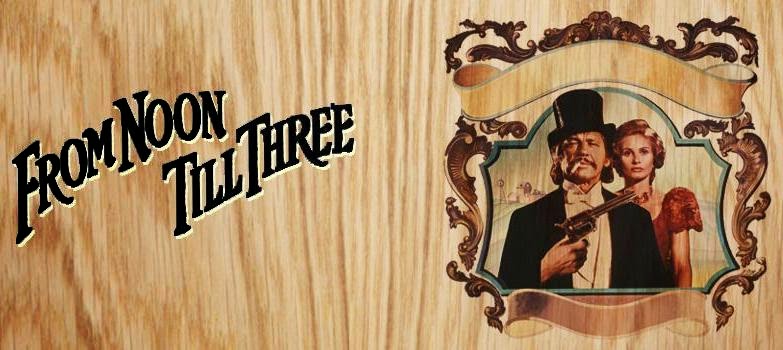From Noon Till Three (1975)
FROM NOON TILL THREE
Bronson is an amateur bank robber, Graham Dorsey, who’s having premonitions about the next heist ending in disaster and therefore tricks his partners so he can spend three hours in the company of a rich widow while his friends are trying to rob a bank. The two feel attracted to each other and they’re still cuddling when the news comes that the heist has gone wrong. Dorsey rides off to saves his friends from being hanged, but is killed when his trail is picked up by the members of a large posse - at least that’s what the lady thinks. With the help of a newspaper journalist she turns the little liason into the romance of the century and her myth-making is so successful that Dorsey becomes a romantic legend and the mansion in which the romance took place a tourist attraction.
Dorsey, who didn’t ride off to save his friends (because he didn’t care about them) and therefore wasn’t killed, finally shows up at the tourist attraction, making the tour incognito, only to discover that the legend has become more important than the facts: the lady is totally absorbed by the image she has created in her book - that of a man who’s everything Graham Dorsey is not: tall, brave and handsome - and only recognizes him after he has shown her that one body part she could not describe in a 19th Century dime novel. She then decides to preserve the legend, leaving it to Dorsey to reclaim his identity - a job that’s far beyond him, and will eventually drive him crazy.
Chuck and Jill aren’t the greatest of actors, and their comedy talents are limited, but their clumsy efforts to be funny add a touch of charm to those scenes of their uneasy flirtations. After all they’re supposed to be a very odd couple, a small time crook, a good for nothing who never knew true love, and a woman who married a much older man for safety, who never knew real passion. It’s also an advantage that Bronson and Ireland were a real-life couple: they must have been physically attracted to each other, which makes it more plausible that the two would have a quick liason under the given circumstances.
Beginning with a nightmare and ending in madness, the script has a nice circular structure, and the central theme of myth-making is intriguing and witty. But the movie fails to come up with a central idea to bundle all these scattered ideas about identity, false heroics and self-delusion. The Lady’s decision to preserve the legend is no doubt a nod towards the famous line - “When the legend becomes fact, print the legend!" - from John Ford’s The Man who Shot Liberty Valence and there are a couple of references to other movies: the scene in which Bronson fakes impotency (to win the lady’s sympathy) echoes a similar scene (with Tony Curtis and Marilyn Monroe) in Some Like it Hot and Bronson’s nightmare about the heist going wrong, looks like a spoofy version of the opening scene of Sam Peckinpah’s The Wild Bunch. Jill Ireland’s character is by the way called Mrs. Starbuck, another reference to Peckinpah’s movie: the opening massacre of The Wild Bunch took place in a Texas border town called Starbuck.
Dir: Frank D. Gilroy - Cast: Charles Bronson, Jill Ireland, Douglas V. Fowley, Stan Haze, Hector Morales, Damon Douglas
BOTTOM LINE:
A comedy (rather than a western) that isn’t great, but has its moments. Some nice references to classic movies add to the fun.







.jpg)
Comments
Post a Comment